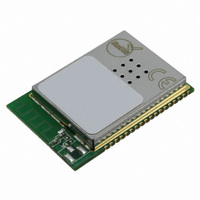MRF24WB0MA/RM Microchip Technology, MRF24WB0MA/RM Datasheet - Page 23

MRF24WB0MA/RM
Manufacturer Part Number
MRF24WB0MA/RM
Description
TXRX RF 2.4GHZ PCB ANT 802.11B
Manufacturer
Microchip Technology
Specifications of MRF24WB0MA/RM
Frequency
2.4GHz
Data Rate - Maximum
1Mbps
Modulation Or Protocol
802.11 b
Applications
ISM
Power - Output
10dBm
Sensitivity
-91dBm
Voltage - Supply
2.7 V ~ 3.6 V
Current - Receiving
85mA
Current - Transmitting
154mA
Data Interface
PCB, Surface Mount
Antenna Connector
On-Board, Trace
Operating Temperature
0°C ~ 70°C
Package / Case
Module
Wireless Frequency
2.4 GHz
Interface Type
SPI, JTAG
Board Size
21 mm x 31 mm
Modulation
DSSS
Security
WEP, WPA-PSK, WPA-2-PSK
Operating Voltage
2.7 V to 3.6 V
Antenna
PCB Meander
Operating Temperature Range
0 C to + 70 C
Frequency Rf
2.4GHz
Transmit Power
9mW
Module Interface
SPI, 4-Wire
Modulation Type
DSSS
Data Rate Max
2Mbps
Supply Current
154mA
Supply Voltage Range
2.7V To 3.6V
Frequency Range
2.4GHz
Leaded Process Compatible
Yes
Rohs Compliant
Yes
For Use With/related Products
PIC18, PIC24, dsPIC33, PIC32
Lead Free Status / RoHS Status
Lead free / RoHS Compliant
Memory Size
-
Lead Free Status / Rohs Status
Lead free / RoHS Compliant
Available stocks
Company
Part Number
Manufacturer
Quantity
Price
Company:
Part Number:
MRF24WB0MA/RM
Manufacturer:
MICROCHIP
Quantity:
2 000
From “Section 7.1.6, RSS-Gen”, Issue 2, June 2007,
Digital Circuits:
3.2.1
Industry Canada:
http://www.ic.gc.ca/
3.3
The MRF24WB0MA/MRF24WB0MB module has been
certified for use in European countries. The following
testing has been completed:
Test standard ETSI EN 300 328 V1.7.1 (2006-10):
• Maximum Transmit Power
• Maximum EIRP Spectral Density
• Frequency Range
• Radiated Emissions
Test standards ETSI EN 301 489-1:2008 and ETSI EN
301 489-17:2008:
• Radiated Emissions
• Electro-Static Discharge
• Radiated RF Susceptibility
The modules are fully compliant with
• Radiated Emissions EN 55022
• Electrostatic Discharge EN 61000-4-2
• Radiated Immunity EN 61000-4-3
• EN 60950-1
• CE-Mark
• RoHS
ETSI does not provide a modular approval similar to
the USA (FCC) and Canada (IC). However, the testing
completed above can be used as part of the customer’s
application for certification. The test report data can be
included in their test plan and can significantly the
lower customer’s certification burden.
A helpful document that can be used as a starting point
in understanding the use of Short Range Devices
(SRD) in Europe is the European Radio Communica-
tions Committee (ERC) Recommendation “70-03 E”,
downloadable
Communications Office (ERO): http://www.ero.dk
2010 Microchip Technology Inc.
“If the device contains digital circuitry that is not
directly associated with the radio transmitter, the
device shall also have to comply with ICES-003,
Class A or B as appropriate, except for ICES-003
labeling requirements. The test data obtained (for
the ICES-003 tests) shall be kept by the manufac-
turer or importer whose name appears on the
equipment label, and made available to Industry
Canada on request, for as long as the model is
being marketed in Canada.”
Europe
HELPFUL WEB SITES:
from
the
European
MRF24WB0MA/MRF24WB0MB
Radio
Preliminary
The end user is responsible for ensuring compliance
with harmonized frequencies and labeling require-
ments for each country in which the end device is
marketed and sold.
3.3.1
Radio and Telecommunications Terminal Equipment
(R&TTE):
http://ec.europa.eu/enterprise/rtte/index_en.htm
European
Telecommunications Administrations (CEPT):
http://www.cept.org/
European Telecommunications Standards Institute
(ETSI):
http://www.etsi.org/
European Radio Communications Office (ERO):
http://www.ero.dk/
3.4
Wi-Fi Alliance Certification focuses on interoperability
testing of devices based on 802.11 standards.
Historically, when the certification process and pro-
grams were developed by Wi-Fi Alliance members, the
vast majority of the 802.11 clients were PC-centric, and
certification testing adequately addressed those types
of devices. In subsequent years, the number of Wi-Fi
devices that are not PC-centric has grown significantly.
These non-standard devices, as a class of products,
have been dubbed Application Specific Devices
(ASDs) by the Wi-Fi Alliance. ASDs are 802.11
devices, e.g., clients or access points (APs), which
cannot be tested under a standard Alliance test plan
because they do not comply with the standard test con-
figuration and/or because they are designed to perform
a specific application. Examples include, but are not
limited to: bar code scanners, pagers, recording
devices, monitoring equipment, and cable modems.
The APs or clients that are used to validate ASD com-
pliance (from the standard test bed) will meet all of the
requirements specified in the applicable System
Interoperability Test Plans (referred to as the “standard
test
MRF24WB0MA and MRF24WB0MB modules are in
the ASD category.
The modules are certified under Wi-Fi 802.11 with
WPA2, WPA, and WEP System Interoperability ASD
Model Test Plan with Test Engine For IEEE 802.11a, b,
and g Devices (Version 1.0).
plan”),
Wi-Fi® Alliance
HELPFUL WEB SITES:
Conference
unless
specifically
of
DS70632A-page 23
exempted.
Postal
and
The












